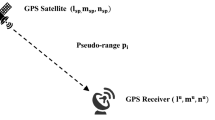Abstract
Global Positioning System encounters many problems in urban canyons and hard environments because of obstacles that decrease the number of visible satellites in receiver view. So, integration with other satellite-based navigation systems such as Russian Global Navigation Satellite System is utilized in new receivers. Least square as the popular and usual method typically used for navigation solution associates all satellite information with the same weights. However, the satellite impacts in reliability and accuracy of the receiver outputs are different in real condition and can be weighted by intelligent factors. In this paper, an improved fuzzy-weighted least square method is proposed which weights the satellite based on the satellite effect on dilution of precision, elevation angle and a defined constellation factor. Experimental results show that the proposed method can calculate 2D position more reliable and accurate than other popular weighted least square methods. This improvement is more than 57.23 % in a defined figure of merit.











Similar content being viewed by others
References
Marais, J., Nahimana, D. F., Viandier, N., & Duflos, E. (2013). GNSS accuracy enhancement based on pseudo range error estimation in an urban propagation environment. Journal of Expert Systems with Applications, 40(15), 5956–5964.
Kuusniemi, H.,& Lachapelle, G. (2004). “GNSS Signal Reliability Testing in Urban and Indoor Environments”, Proceedings of ION NTM Conference (pp. 1–15).
Cai, C., & Gao, Y. (2009). “A combined GPS/GLONASS navigation algorithm for use with limited satellite visibility”. The Journal of Navigation, 62(4), 671–685.
Angrisano, A., Gaglione, S., & Gioia, C. (2013). Performance assessment of GPS/GLONASS single point positioning in an urban environment. Journal of Acta Geodaetica et Geophysica, 48(2), 149–161.
Jokinen, A., Feng, S., Milner, C., Schuster, W., & Ochieng, W. (2011). “Precise Point Positioning and Integrity Monitoring with GPS and GLONASS”, European Navigation Conference (pp.1–12).
Melgard, T., Vigen, E.,& Orpen, O.(2009). “Advantages of Combined GPS and GLONASS PPP -Experiences based on G2, A New Service from Fugro”, 13th IAIN World Congress (pp. 1–7).
Azami, H., Mosavi, M. R., & Sanei, S. (2013). Classification of GPS satellites using improved back propagation training algorithms. Journal of Wireless Personal Communications, 71(2), 789–803.
Saraf, M., Mohammadi, K., & Mosavi, M. R. (2011). Bayesian framework on GPS GDOP classification. Journal of Computers and Electrical Engineering, 37, 1009–1018.
Mosavi, M. R., Azarshahi, S., EmamGholipour, I., & Abedi, A. A. (2014). Least squares techniques for gps receivers positioning filter using pseudorange and carrier phase measurements. Iranian Journal of Electrical and Electronic Engineering, 10(1), 18–26.
Tay, S., & Marais, J. (2013).“Weighting Models for GPS Pseudorange Observations for Land Transportation in Urban Canyons”, 6th European Workshop on GNSS Signals and Signal Processing (pp. 1–4).
Rahemi, N., Mosavi, M. R., Abedi, A. A., & Mirzakuchaki, S. (2014). Accurate solution of navigation equations in GPS receivers for very high velocities using pseudorange measurements. Journal of Advances in Aerospace Engineering, 2014(2014), 1–8.
Mosavi, M. R. (2004). “Fuzzy Point Averaging of the GPS Position Components”, 3th Annual Conference and Exhibition on Geographical Information Technology and Applications.
Groves, P. D. (2011). Shadow matching: A new GNSS positioning technique for urban canyons. The Journal of Navigation, 64, 417–430.
Wang, K., & Zhao, L. (2014). “GPS/INS Integrated Urban Navigation System Based on Vehicle Motion Detection”, IEEE Chinese Guidance, Navigation and Control Conference (CGNCC) (pp. 667–670).
Won, D. H., Lee, E., Heo, M., Sung, S., Lee, J., & Lee, Y. J. (2014). GNSS integration with vision-based navigation for low GNSS visibility conditions. Journal of GPS Solutions, 18(2), 177–187.
Aumayer, B. M., Petovello, M. G.,& Lachapelle, G. (2014).“Development of a Tightly Coupled Vision/GNSS System”, the 27th International Technical Meeting of The Satellite Division of the Institute of Navigation (pp. 2202–2211).
Mosavi, M. R., & EmamGolipour, I. (2013). De-noising of GPS receivers positioning data using wavelet transform and bilateral filtering. Journal of Wireless Personal Communications, 71(3), 2295–2312.
Li, P., & Zhang, X. (2014). Integrating GPS and GLONASS to accelerate convergence and initialization times of precise point positioning. Journal of GPS Solutions, 18(3), 461–471.
Blanch, J., Walter, T., & Enge, P. (2012). Satellite navigation for aviation in 2025. Proceedings of the IEEE, 100(No.Special Centennial Issue), 1821–1830.
Wang, J., & Rizos, C. (2001). GPS and GLONASS integration: Modeling and ambiguity resolution issues. Journal of GPS Solutions, 5(1), 55–64.
Walter, T., Blanch, J., Choi, M. J., Reid, T., & Enge, P. (2013).“Incorporating GLONASS into Aviation RAIM Receivers”, the International Technical Meeting of the ION (pp. 239–249).
Mosavi, M. R., & Rahemi, N. (2015). Positioning performance analysis using RWLS algorithm based on variance estimation methods. Journal of Aerospace Science and Technology, 42, 88–96.
Li, J., & Wu, M. (2009). “The Improvement of Positioning Accuracy with Weighted Least Square Based on SNR”, IEEE Conference on Wireless Communications, Networking and Mobile Computing (pp. 1−4).
Rahemi, N., Mosavi, M. R., Abedi, A. A., & Mirzakuchaki, S. (2014). Accurate solution of navigation equations in GPS receivers for very high velocities using pseudorange measurements. Journal of Advances in Aerospace Engineering, 2014, 1–8.
Yang, Q., & Sun, J. (2007). “A Location Method for Autonomous Vehicle based on Integrated GPS/INS”, IEEE Conference on Vehicular Electronics and Safety (pp. 1–4).
Lin, C. C., Wang, L. S., Chang, F. R., & Chen, C. C. (2006). Use of residual DOP and genetic algorithm in weighted-least-square GPS positioning”, the National Technical Meeting of ION (pp. 508–514).
Borre, K., Akos, D. M., Bertelsen, N., Rinder, P., & Jensen, S. H. (2007). A software-defined GPS and Galileo receiver: A single-frequency approach, applied and numerical harmonic analysis. Boston: Birkhauser.
Author information
Authors and Affiliations
Corresponding author
Rights and permissions
About this article
Cite this article
Tabatabaei, A., Mosavi, M.R., Khavari, A. et al. Reliable Urban Canyon Navigation Solution in GPS and GLONASS Integrated Receiver Using Improved Fuzzy Weighted Least-Square Method. Wireless Pers Commun 94, 3181–3196 (2017). https://doi.org/10.1007/s11277-016-3771-1
Published:
Issue Date:
DOI: https://doi.org/10.1007/s11277-016-3771-1




